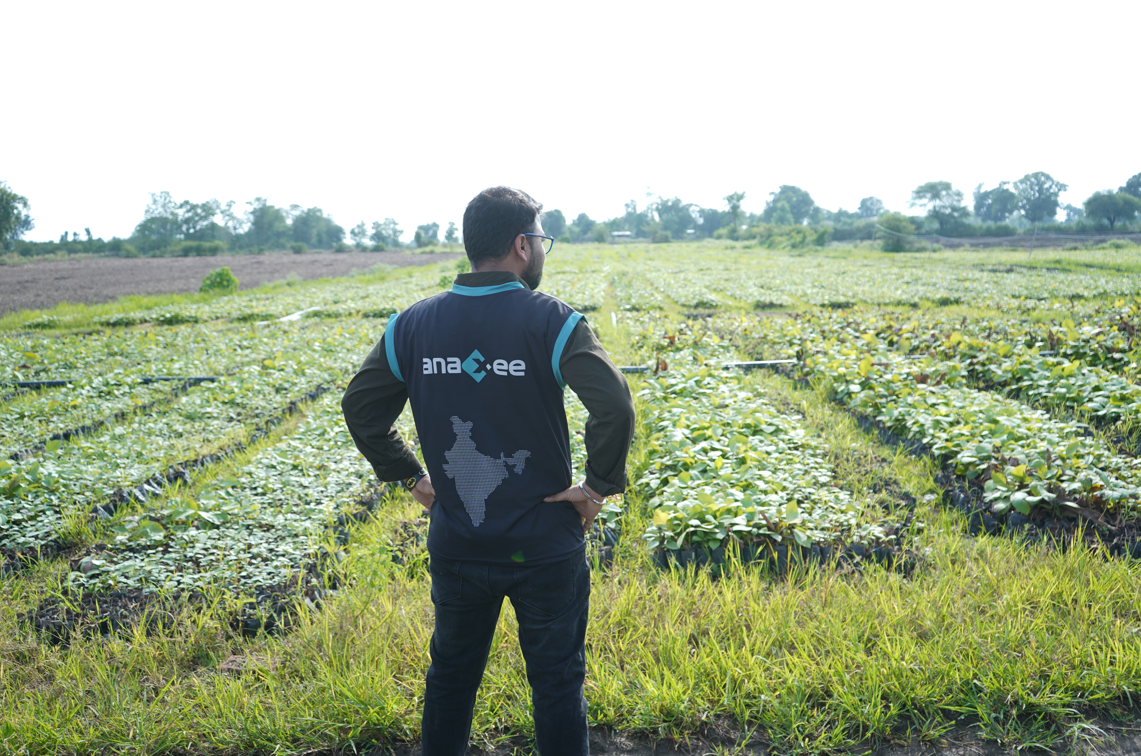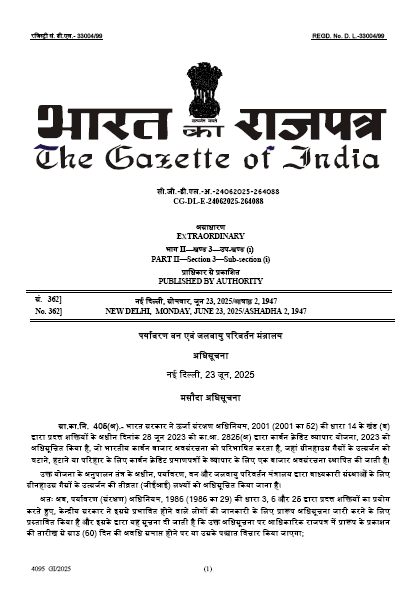🇮🇳 India’s Big Carbon Shift: CCTS 2023 and GHG Targets 2025
India is undergoing a major climate policy transformation. On 23rd June 2025, the Government of India released a Gazette notification announcing the next operational phase of its Carbon Credit Trading Scheme (CCTS), 2023. The focus? Setting clear, industry-specific greenhouse gas (GHG) emission intensity targets for key sectors like steel, aluminum, and power for compliance years 2025-26 and 2026-27.
This is no longer a voluntary move- it is regulation-backed, compliance-enforced, and GHG-accounted.
To download ‘The Gazette of India’- Click below:
What is the Carbon Credit Trading Scheme (CCTS), 2023?
CCTS was first notified in June 2023. It was designed to create a formal, compliance-based carbon market in India. Think of it as a stock exchange—except, instead of trading shares, industries trade carbon credit certificates, representing a reduction or avoidance of one tonne of CO₂ equivalent.
Under this system, each eligible industry has to meet specific Emission Intensity Targets (EI targets)—defined as tonnes of CO₂ emitted per tonne of product output. If they emit less than their allocated target, they can earn credits. If they emit more, they must purchase credits or face penalties.
The scheme’s primary legal basis comes from:
- The Energy Conservation Act, 2001
- The Environment (Protection) Act, 1986
- The Electricity Act, 2003
The Bureau of Energy Efficiency (BEE) acts as the nodal implementation body under the Ministry of Environment, Forest and Climate Change (MoEFCC).
What Was Notified in the June 2025 Gazette?
The notification lists 118 companies across sectors and their:
- Baseline GHG Emission Intensity (2023-24)
- Assigned GHG Emission Intensity Targets for 2025-26 and 2026-27
- Primary production output (e.g., crude steel, aluminum)
This step operationalizes the compliance mechanism of the CCTS and sets the tone for India’s decarbonization via market forces.
Emission Intensity Targets: What Does the Data Say?
To give you a clearer picture, here’s a sample table extracted from the Gazette:
| Company Name | Sector | Baseline Intensity (tCO₂e/ton) | Target 2025-26 | Target 2026-27 |
| Hindalco Industries Ltd (Taloja) | Aluminum | 1.3386 | 1.3057 | 1.2563 |
| Tata Steel Ltd (Jamshedpur) | Iron & Steel | 2.3804 | 2.3362 | 2.2699 |
| JSW Steel Ltd (Dolvi) | Iron & Steel | 2.6662 | 2.6107 | 2.5275 |
| SAIL Bokaro Plant | Iron & Steel | 3.2056 | 3.1254 | 3.0052 |
| Bhushan Power & Steel | Iron & Steel | 3.6421 | 3.5386 | 3.3833 |
What you see here is the government creating a linear decarbonization path—each company must reduce its emission intensity by ~3–5% over two years.
Key Terms You Should Know
Understanding CCTS requires knowing a few core terms:
– Emission Intensity (EI): Emissions per unit of output, usually in tonnes CO₂ equivalent per tonne of product.
– Banked Certificates: Extra credits earned for exceeding targets can be stored (“banked”) for use in future years.
– Compliance Cycle: The period (typically yearly) in which the performance against targets is evaluated.
– Non-Compliance Penalty: If a company fails to meet its targets and does not buy equivalent credits, a financial penalty is imposed—2× the market price of the credit shortfall.
Why This Matters: National and Global Relevance
India has made a Nationally Determined Contribution (NDC) commitment to reduce the emissions intensity of its GDP by 45% by 2030 from 2005 levels. The CCTS operationalization is the first step toward real domestic enforcement.
It’s also relevant for:
– Carbon project developers: as this market can soon become a source of demand for offsets
– Climate finance players: looking to invest in verifiable carbon mitigation
– Industries: navigating the complex transition to net-zero while staying profitable
Who Are the First Movers?
Here are the top 5 largest emitters (by output volume) included in the Gazette:
| Series | Company | Output 2023-24 (Tonnes) | Baseline EI |
| 1 | JSW Steel Ltd (Dolvi) | 8.9 million | 2.6662 |
| 2 | SAIL, Bhilai Steel Plant | 5.67 million | 3.1487 |
| 3 | Tata Steel Ltd (Jamshedpur) | 10.7 million | 2.3804 |
| 4 | Rashtriya Ispat Nigam Ltd | 4.4 million | 2.9781 |
| 5 | JSPL (Raigarh) | 3.25 million | 3.2231 |
These companies are now part of a high-stakes, market-driven push toward decarbonization.
Compliance Rules: How Does It Work?
Every designated unit must:
- Register on the Indian Carbon Market (ICM) portal.
- Submit verified documents and data using the official protocol.
- Show either:- Achieved GHG intensity target, or
– Bought carbon credits from the ICM exchange, or
– Used banked credits
If not, penalties kick in via the Central Pollution Control Board (CPCB).
How Are Credits Calculated?
There’s a specific formula for computing tradable credits:
Credits Earned = (EI Target − Actual EI) × Output
And for those falling short:
Credits to be Bought = (Actual EI − EI Target) × Output
This is a transparent, formula-based system—favoring those that proactively decarbonize.
Road Ahead: A Market in the Making
The CCTS isn’t just another scheme—it is the birth of India’s compliance carbon market, like the EU ETS or China’s national trading platform. And it’s different from voluntary offsets. It’s mandatory for large emitters.
Some predictions:
– Expect a secondary market for trading excess certificates.
– Tech companies will emerge for MRV (Monitoring, Reporting, Verification).
– Integration with Article 6 of the Paris Agreement could follow, allowing international trade.
What Should Companies Do Now?
If you’re an industrial entity in India with significant emissions, this notification is your wake-up call. Immediate steps:
– Audit your emissions and production data
– Check your EI targets vs. your baseline
– Engage with accredited verifiers and BEE procedures
– Plan internal decarbonization OR credit purchase strategy
The Carbon Credit Trading Scheme 2023, now backed by enforceable GHG intensity targets, is a landmark reform. It shifts India from voluntary green gestures to enforceable emission regulation- with a built-in market mechanism. It aligns environmental responsibility with business competitiveness.
If implemented with transparency and rigor, this system can help India leap ahead in its climate commitments while building a robust domestic carbon economy.
Are you a heavy emitter, industrial SME, or climate consultant? Anaxee’s Tech-for-Climate network is ready to support your MRV, compliance documentation, and grassroots engagement.
Reach out today- sales@anaxee-wp-aug25-wordpress.dock.anaxee.com and be part of India’s green transition.




